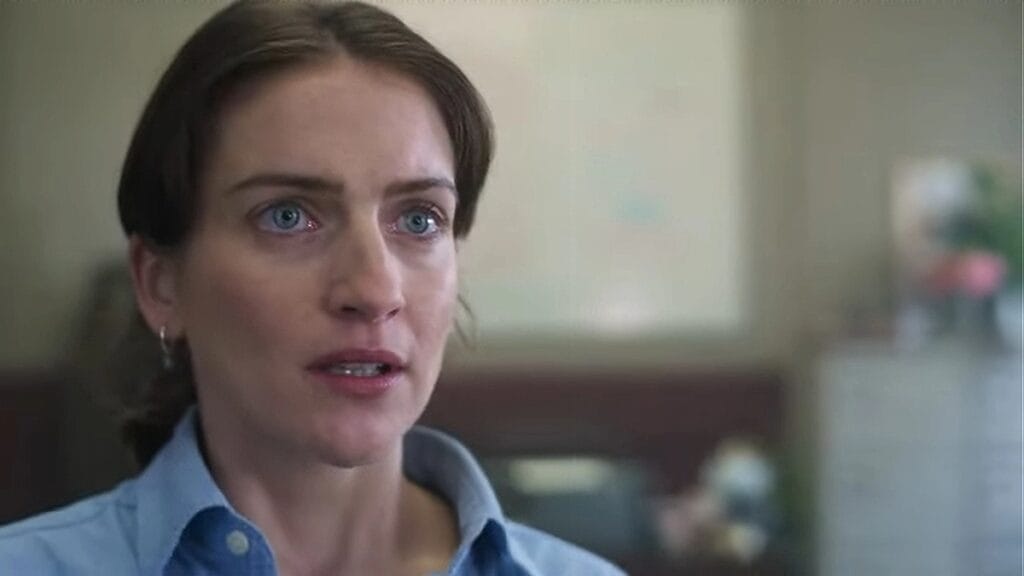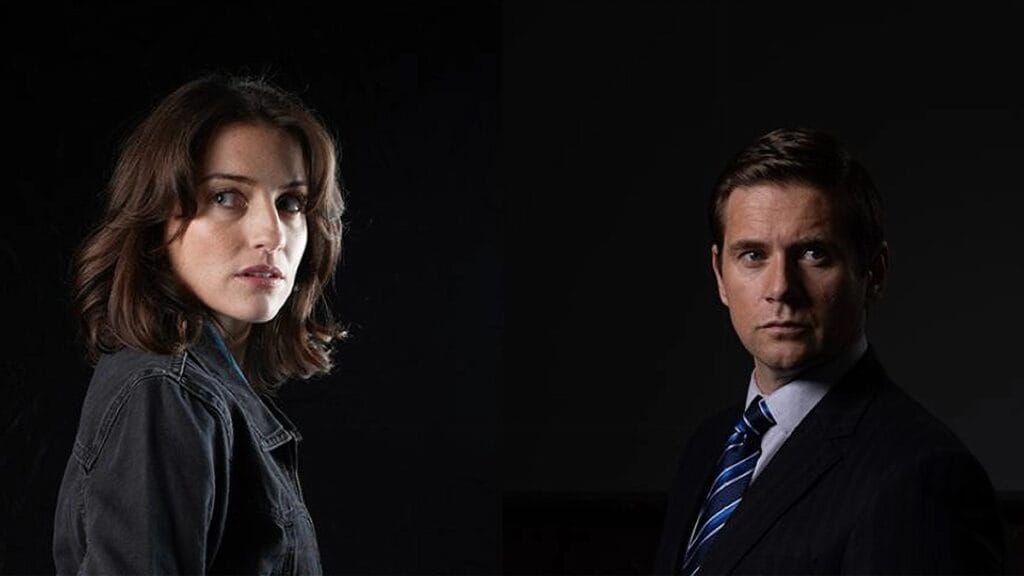The Sundance Now drama’s empathy elevates it above more typical offerings in the genre even as its ending disappoints.
This piece was written during the 2023 SAG-AFTRA strikes. Without the labor of the actors currently on strike, the works being covered here wouldn’t exist.
The Vanishing Triangle takes its name from media shorthand for an approximately 80-mile area in Eastern Ireland. For almost 20 years, from the late 70s to the late 90s, the Triangle suffered through several unsolved crimes. The victims, women ranging from teens to in their thirties, disappeared at an alarming rate. Additionaly, several murders of women in the area during the period were frequently linked in the press. Some speculated a serial killer’s (or serial killers’s) involvement, but the Gardaí—Ireland’s national police—never made such a declaration. As The Irish Times noted, “the ‘vanishing triangle’ phenomenon [is] a media creation rather than a Garda theory.”
For Americans, the Missing and Murdered Indigenous Women crisis might be a useful frame for understanding the vanishing triangle. While considerably more widespread in the United States, both reflect a cluster of tragedies that have gone unanswered due to mistakes, indifference, implicit and explicit judgments about the victims, and systemic limitations. As a result, suggesting that these deaths and disappearances are the work of a serial killer is reductive. It risks ignoring many other societal factors that gave rise to an environment where such crimes occurred largely unchecked.
The Vanishing Triangle demonstrates an understanding of that delicacy while still seeking to dramatize the era. It proposes the specific series of crimes investigated in this series could indicate the work of serial killer. Still, it doesn’t ever widen the scope further or bring in true murdered or disappeared women to bolster its case. Additionally, the series works hard to highlight the other factors that may have undermined the Garda’s efforts. These elements include malignant elements like institutional arrogance, dismissal of sex workers as “worthy” victims, and police corruption. Additionally, it notes institutional and technical limitations like the lack of a countrywide coordinated missing persons database.

Starting a review with the three paragraphs above may set a reader’s teeth on edge. It does suggest the series might be more akin to homework than televised entertainment. Its thoughtfulness, however, is an asset, not a demerit. The Ivan Kavanagh series does not lack tension or strong characterization because it refuses the cheaper route. It provides the same drama and intensity that draw people to fictionalized accounts of true crime without the gross aftertaste of exploitation.
Lisa Wallace (India Mullen) is a newspaper reporter in Dublin. In an attempt to salvage a story, she reveals to her editors the home invasion and murder of her mother, a crime she witnessed. The newspaper lets her write the story, including how her tragic past informs the current situation. However, once she turns the piece in, the paper sensationalizes it with an enormous banner headline that makes Wallace’s trauma the focus.
The Vanishing Triangle demonstrates an understanding of that delicacy [of being respectful to victims] while still seeking to dramatize the era.
After the reporter’s exposure, Susan Reynolds (Laoise Sweeney) seeks out Wallace to help find her sister Amy. Amy, a girl in her 20s, missed the last bus home from a bar and had been missing since. The police largely waived off her disappearance as the act of promiscous woman still at her one night’s stand’s house. The reporter also receives a note from a man implying he both killed her mother and is responsible for Amy’s disappearance. Understandably frightened, Wallace takes the letter to the Gardaí, finding an ally in Detective David Burke (Allen Leech). His efforts, however, run aground of internal politics and threats to expose his secrets.
Kavanaugh and his team of women writers—Sally Tatchell and Rachel Anthony—and directors—Imogen Murphy and Laura Way—effectively humanize the victims and their families while exploring how they could be the people paid to protect the population could so easily write off these women. The series effectively frames people’s faces to capture subtle shifts in mood. They also well utilize medium and long shots to dial up tension and reveal danger to the audience before the characters can clock it.

Unfortunately, considering all The Vanishing Triangle does right, the series concludes on a bum note. It seems to be rushing its conclusion after six episodes of deliberate and tightly managed pacing. It runs two brief monologue scenes between moments in the credits, like a student sneaking in just one more thought on an essay test. Moreover, the fate of one character who seemingly has finally fully come into their own feels both unsatisfyingly abrupt and echoes an unfortunate trope. After managing so many potentially disappointing elements so well for almost 270 minutes over six episodes, fumbling the last ten sends the audience off with a sour taste.
Nonetheless, it isn’t nearly enough to not recommend the series. Mullen and Leach give the kind of performances that make acting seem easy. They slip into the characters that well. In a cast populated by strong supporting performances, Philip O’Sullivan deserves a special shout-out as a figure symbolic of the Old Guard’s rot and limitations. His performance captures both how dangerous such people can be and how quickly they can be made weak in the face of resistance. A poor ending is a poor ending, for sure, but The Vanishing Triangle does too much well to be written off for its conclusion.
The Vanishing Triangle stalks Ireland’s bogs on AMC+ starting October 26.
Read next: The Spool's Best New Releases
Streaming guides
The Best Live TV Streaming Services With Free Trial
The praises of live TV streaming services don’t need to be further sung. By now, we all know that compared to clunky, commitment-heavy cable, live TV is cheaper and much easier to manage. But just in case you’re still on the fence about jumping over to the other side, or if you’re just unhappy with ... The Best Live TV Streaming Services With Free Trial
How to Watch Power Book III: Raising Kanan Season 3
Season 3 of the hotly anticipated Power spin-off, Power Book III: Raising Kanan, is arriving on Starz soon, so you know what that means: it’s the ’90s again in The Southside, and we’re back with the Thomas family as they navigate the ins and outs of the criminal underworld they’re helping build. Mekai Curtis is ... How to Watch Power Book III: Raising Kanan Season 3
How to Watch Doctor Who: 60th Anniversary Specials
Ladies and gentlemen, we’re so back! To celebrate Doctor Who’s 60th anniversary, the BBC is producing a three-episode special starring none other than the Tenth/Fourteenth Doctor himself, David Tennant. And to the supreme delight of fans (that would be me, dear reader), the Doctor will be joined by old-time companion Donna Noble (Catherine Tate) and ... How to Watch Doctor Who: 60th Anniversary Specials
Which Netflix Country has Interstellar?
Maybe you’ve just seen Oppenheimer and have the strongest urge to marathon—or more fun yet, rank!—all of Christopher Nolan’s films. Or maybe you’re one of the few who haven’t seen Interstellar yet. If you are, then you should change that immediately; the dystopian epic is one of Nolan’s best, and with that incredible twist in ... Which Netflix Country has Interstellar?
Which Netflix Country Has Each Movie of The Hunger Games?
For whatever reason, The Hunger Games series isn’t available in the same countries around the world. You’ll find the first and second (aka the best) installments in Hong Kong, for instance, but not the third and fourth. It’s a frustrating dilemma, especially if you don’t even have a single entry in your region, which is ... Which Netflix Country Has Each Movie of The Hunger Games?
How to Watch ESPN With A Free Trial
One of the major concerns people have before cutting the cord is potentially losing access to live sports. But the great thing about live TV streaming services is that you never lose that access. Minus the contracts and complications of cable, these streaming services connect you to a host of live channels, including ESPN. So ... How to Watch ESPN With A Free Trial
How to Watch Paramount Network With a Free Trial
To date, Paramount Network has only two original shows on air right now: Yellowstone and Bar Rescue. The network seems to have its hands full with on-demand streaming service Paramount+, which is constantly stacked with a fresh supply of new shows. But Yellowstone and Bar Rescue are so sturdy and expansive that the network doesn’t ... How to Watch Paramount Network With a Free Trial
How to Watch WE TV With a Free Trial
Previously “Women’s Entertainment,” We TV has since rebranded to accurately reflect its name and be a more inclusive lifestyle channel. It’s home to addictive reality gems like Bold and Bougie, Bridezillas, Marriage Boot Camp, and The Untold Stories of Hip Hop. And when it’s not airing original titles, it has on syndicated shows like 9-1-1, ... How to Watch WE TV With a Free Trial
How to Watch TNT Sports With A Free Trial
For many sports fans, TNT is a non-negotiable. It broadcasts NBA, MLB, NHL, college basketball, and All Elite Wrestling matches. And, as a bonus, it also has reruns of shows like Supernatural, Charmed, and NCIS, as well as films like The Avengers, Dune, and Justice League. But while TNT used to be a cable staple, ... How to Watch TNT Sports With A Free Trial
How to Watch Comedy Central With a Free Trial
It’s no coincidence that many of today’s biggest comedians found their footing on Comedy Central: the channel is a bastion of emerging comic talents. It served as a playground for people like Nathan Fielder (Fielder For You), Ilana Glazer and Abbi Jacobson (Broad City), Tim Robinson (Detroiters), and Dave Chappelle (Chappelle’s Show) before they shot ... How to Watch Comedy Central With a Free Trial
How to Watch FX With a Free Trial
You’d be hard-pressed to find a bad show airing on FX. The channel has made a name for itself as a bastion of high-brow TV, along with HBO and AMC. It’s produced shows like Atlanta, Fargo, The Americans, Archer, and more recently, Shogun. But because it’s owned by Disney, it still airs several blockbusters in ... How to Watch FX With a Free Trial